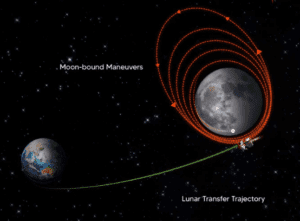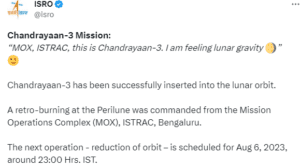In a momentous achievement for India’s space agency, the Indian Space Research Organisation (ISRO), Chandrayaan-3 has successfully entered the lunar orbit. The crucial milestone was reached after a precise retro-burning maneuver at the Perilune, expertly commanded from the Mission Operations Complex (MOX) at ISTRAC in Bengaluru.

The Indian Space Research Organisation (ISRO) successfully inserted Chandrayaan-3 into lunar orbit on today (Saturday, August 5, 2023),and ISRO twitted and confirm it . The manoeuvre was performed when Chandrayaan-3 was at its closest point to the Moon (perilune), and was commanded from the Mission Operations Complex (MOX) at ISRO’s Satellite Tracking and Command Network (ISTRAC) in Bengaluru.
- A Moment of Pride for India
Chandrayaan-3’s successful insertion into the lunar orbit marks a significant leap forward in India’s space exploration endeavors. It demonstrates the nation’s growing capabilities in the field of space science and technology, cementing India’s position as a formidable player in the global space community.

- The Retro-Burning Perilune Maneuver
The key to Chandrayaan-3’s successful lunar orbit insertion was the precisely executed retro-burning maneuver at the Perilune. This crucial operation involved firing the spacecraft’s engines in the opposite direction of its motion to reduce its velocity and allow it to be captured by the moon’s gravitational pull.
- Mission Operations Complex (MOX) at ISTRAC, Bengaluru
The Mission Operations Complex (MOX) at ISTRAC in Bengaluru played a pivotal role in the success of Chandrayaan-3’s lunar orbit insertion. It served as the nerve center for the mission, where highly skilled and dedicated scientists and engineers monitored and executed the complex maneuvers with exceptional precision.

- Chandrayaan-3: A Quest for Lunar Exploration
Chandrayaan-3 is India’s third lunar mission and is a part of its continued quest for lunar exploration. Building upon the achievements of its predecessors, Chandrayaan-1 and Chandrayaan-2, this mission aims to further unravel the mysteries of the moon and contribute valuable scientific knowledge to the world.
- The Importance of Lunar Orbit Insertion
The successful insertion of Chandrayaan-3 into the lunar orbit is a critical phase of the mission. It positions the spacecraft in the desired orbit around the moon, allowing it to conduct scientific observations, gather data, and carry out experiments to study the lunar surface and its environment.

- A Step Towards Lunar Landing
With Chandrayaan-3 now securely in the lunar orbit, the next phase of the mission will involve careful planning and execution for a soft landing on the moon’s surface. This challenging feat requires meticulous precision, as the spacecraft needs to safely descend and touchdown on the moon without any damage.
- Contributing to Global Scientific Knowledge
Chandrayaan-3’s successful lunar orbit insertion is not only a matter of national pride but also a significant contribution to global scientific knowledge. The data and insights gathered during the mission will aid scientists in understanding the moon’s geological evolution, its resources, and its potential for future human exploration.
- Inspiring Future Generations
The successful insertion of Chandrayaan-3 into the lunar orbit serves as an inspiration for the nation’s youth and future generations. It encourages aspiring scientists and engineers to dream big and pursue careers in space exploration, fueling the passion for science and technology in India.

- A Promising Future
As Chandrayaan-3 embarks on its journey of lunar exploration, it paves the way for more ambitious space missions from India in the future. With each milestone achieved, ISRO solidifies its position as a global leader in space exploration, opening doors to new frontiers and discoveries that will shape the future of humanity’s journey into the cosmos.



- What’s Next for Chandrayaan-3?


Here are some additional details about the retro-burning maneuver:
- The maneuver was performed using the spacecraft’s main engine.
- The burn lasted for approximately 15 seconds.
- The maneuver reduced the spacecraft’s velocity by approximately 1.5 kilometers per second.
- The spacecraft’s new orbital parameters are a perigee of 118 kilometers and an apogee of 12,757 kilometers.

Chandrayaan-3’s successful insertion into the lunar orbit is a testament to India’s growing prowess in space technology and exploration. It is a moment of immense pride for the nation and reaffirms ISRO’s commitment to advancing scientific knowledge and pushing the boundaries of human understanding. As the mission progresses, the world eagerly anticipates the invaluable scientific discoveries that await us and the promise of a brighter future in space exploration.
